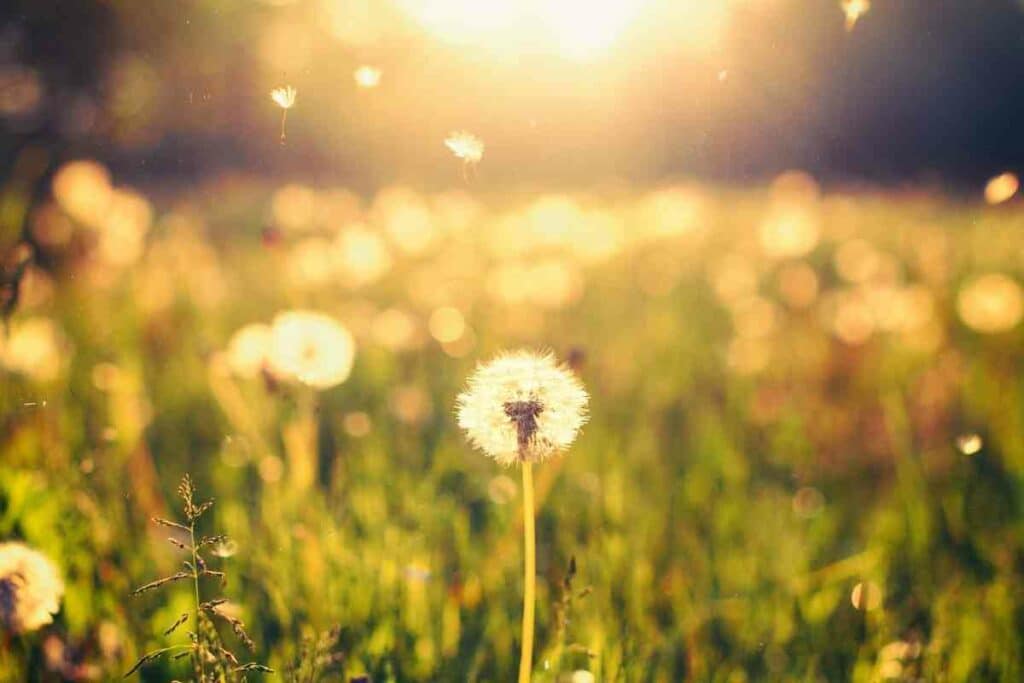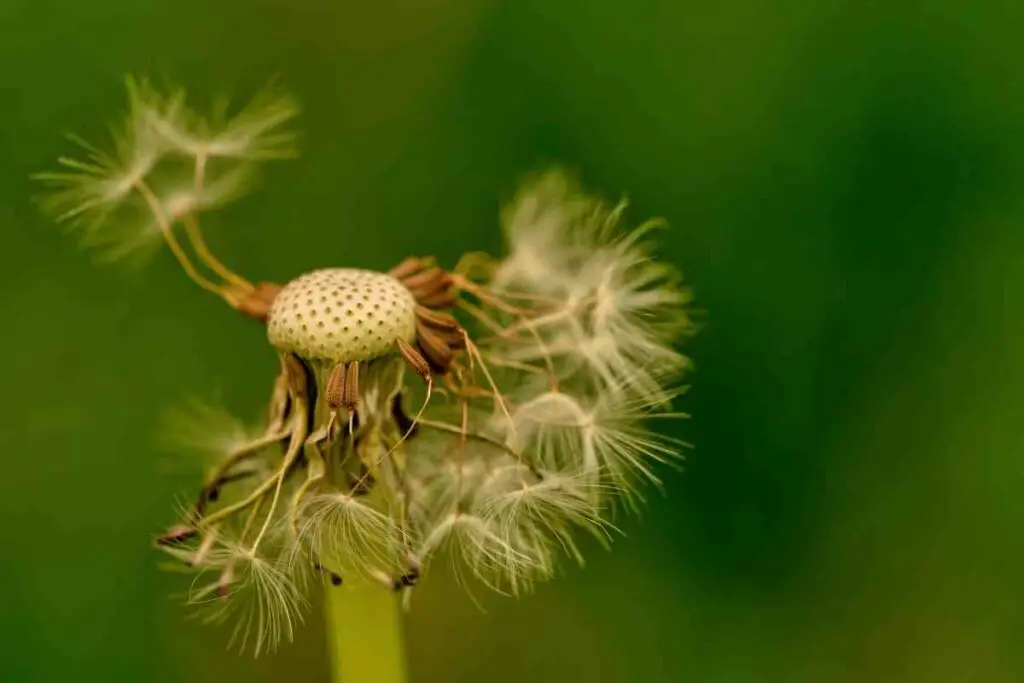Dandelion plants can live for five to ten years and grow up to 20 inches in diameter.
Because dandelions seeds are spread by wind, no lawn or planting bed is safe from a parachuting invasion of dandelion seeds.
Understanding how to get rid of dandelions properly and stop them from spreading and reappearing allows farmers to minimize the amount of work they have to do moving forward.

Dandelions are among the subsets of weeds called broadleaf perennials, which are notoriously challenging to remove, especially once the plant has fully established its ten-inch-long taproot.
To remove dandelions permanently, it is essential to destroy them down to the roots.
Otherwise, it will regrow. Dandelions can be killed permanently and quickly using chemicals or all-natural methods such as broadleaf herbicides, vinegar or vinegar mixture, and boiling water.
However, these products do not discriminate between weed and plant, so one should apply them carefully and in the right conditions.
How to Get Rid Of Dandelions Fast and Permanently
The following methods work wonders at getting rid of dandelions for good.
Pure White Vinegar
Vinegar destroys plant cell membranes, resulting in dehydration of plant tissue and plant death.
The effectiveness of vinegar as an herbicide depends on its concentration and the dandelion’s age.
White horticultural vinegar contains 20% acetic acid and can permanently kill young dandelions. However, vinegar is not strong enough to permanently kill well-established and deep-rooted old dandelions; the potential of vinegar killing them permanently is 50-50.
Choose a sunny day to spray the dandelions because the acetic acid in vinegar dries out weeds; therefore, applying vinegar on a day when the weeds are exposed to at least a few hours of direct sunlight increases the vinegar’s drying power.

Here is the process:
- Fill the spray bottle with undiluted vinegar. You can use a pump sprayer with a long hose and nozzle for a big area.
- Spray directly onto the weeds, cover the leaves of the dandelions with vinegar, and don’t forget to spray down around the roots.
Vinegar raises the soil’s acidity for a long enough period to kill the weed’s roots. Apply only to the unwanted plants.
Within a few hours, the dandelions start withering and browning.
To permanently kill well-established dandelions, spray them with vinegar and uproot them in 3 days after dying.
While using this method, the grass will sustain slight effects.
So, after uprooting the dandelions, water and mow the lawn to wash any traces of vinegar.
From Experience: Spray the weeds in the morning so they can get enough sunlight, and if it suddenly rains shortly after spraying, you’ll most likely need to apply a second round of vinegar.
Vinegar, Salt and Soap Mixture
When looking for a natural alternative to herbicides, a mixture of vinegar, liquid dish soap, and salt contains all the elements needed to end dandelions quickly.

The acetic acid in salt and horticultural vinegar are both very effective at draining moisture from the weed’s root system, making them powerful enough to kill the weed permanently.
The dish soap acts as a surfactant, an agent that lowers surface tension, causing the weed-killing solution to adhere to the leaves, giving the mixture enough time to travel up to the roots.
Stir one cup of salt, a gallon of white vinegar, and one tablespoon of liquid dish wash soap, fill a spray bottle halfway with it, and thoroughly coat all parts of the dandelion, including the roots. The dandelion should wither entirely after about three hours; if not yet, respray it.
They will never return, and nothing else will ever grow there.
Quick Note: Avoid dousing nearby plants because this weed killer can’t differentiate between weeds and plants you’d like to keep.
Boiling Water
Applying boiling water on dandelions is one of the best, most cost-effective, and environmentally friendly methods that one can use for long-term dandelion control.
Hot water produces almost instantaneous results giving you the best results within a day or two.
Because it’s hard to control the flow of the boiling water, this method works best on lawns, driveway cracks, or garden paths.

Start by boiling a large kettle of water on a stove burner or outside burner.
The size of the weeded area should help you determine how much water you’ll need—keeping the kettle’s spout as close as possible to the dandelion’s roots and leaves.
Slowly pour boiling water (above 200 degrees Fahrenheit) over the dandelions and roots. Running boiling water on dandelion leaves causes them to turn yellow and wither fast.
As the water travels quickly and deep into the soil, the heat in the soaked soil around the dandelion’s taproots will burn its sections that connect with the main plant.
The dandelion will die permanently with damaged roots and no leaves to soak in the sun’s nutrients.
Broadleaf Herbicide
Dandelions are among the subsets of broadleaf perennials, which are notoriously challenging to remove, especially once the plant has fully established its ten-inch-long taproot.

The long roots are the only key to permanently eradicating the weed.
Even if a small portion of the dandelion taproot is left behind, the dandelions will surely come again.
Broadleaf herbicide is the quickest and least labor-intensive way of getting rid of dandelions permanently.
Not only will the herbicide kill the leaves but the entire plant.
For most effective broadleaf products, they must contain a combination of two or three herbicides.
MCPP, 2,4-D, dicamba, and triclopyr are among the best broadleaf herbicides and can give you great results, especially when dealing with dandelions.
Broadleaf herbicides work best in the fall when controlling perennial broadleaf weeds. In fall, they transfer food (carbohydrates) from the leaves to the roots for winter preparation.
Therefore, the treatment is transported to the roots along with the carbohydrates, eradicating the dandelions.

Avoid mowing the lawn 2 to 3 days before and after application; allow 3 to 4 days to pass before mowing. This gives the dandelions enough time to absorb the herbicide and translocate it to their roots.
Works Best: Apply broadleaf herbicide when there is no rain predicted for the next 24 hours. Also, do not water the lawn for at least 24 hours after application.
Final Thoughts
Dandelions are notoriously difficult to eradicate because their taproots can reach up to ten inches deep into the soil, and the wind carries their seeds to their next location.
Furthermore, dandelions are perennials, which means they will reappear on their own every year.
The only way to permanently remove them is to remove the entire root system.
The plant will return even if a small portion of a dandelion root is left behind.
